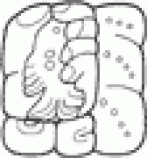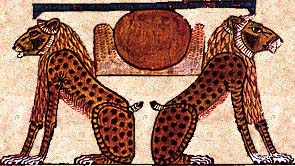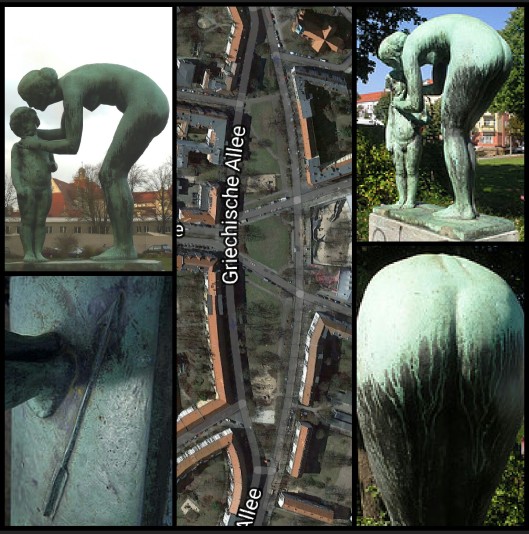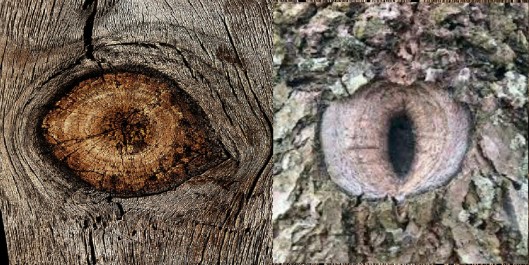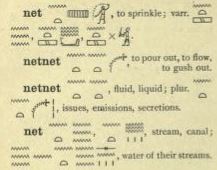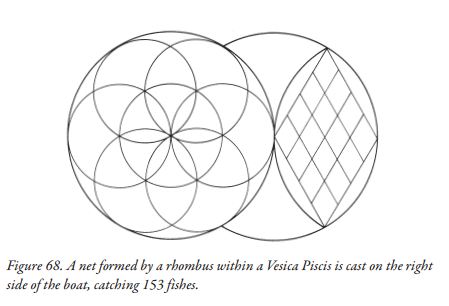In Egyptian Mythology the Waters of Chaos predated all of existence, including the creator god, and were represented by the Anthropomorphic god Nun.
Despite all the various Creation myths that the Egyptians subscribed to, they had one thing in common, Nun. Even though the myths named different gods as the original creator, they all agreed that he sprang from Nun, the primordial waters. Nun was more than an ocean, he was a limitless expanse of motionless water. Even after the world was created, Nun continued to exist at it’s margins and would one day return to destroy it and begin the cycle again.
Our modern creation theories, most commonly, assume that absolutely everything was created by God, who is the only uncreated existence, without exception. Although the book most commonly refered to as the Athority on creation does not actually articulate this as fact. It is an assumtion made by Biblical creation believers, that the creation of water is included in the creation of Earth.
“In the beginning God created the Heavens and the Earth.”
Earth: Strong’s H776, erets – earth, land.
Here we can see that The Bible gives no literal account for the creation of water.
2. And the Earth was without form, and void; and darkness was upon the face of the deep. And the Spirit of God moved upon the face of the waters.
There is also not a record here for the creation of darkness, and as the Spirit of God moved upon the face of the waters, Darkness was upon the face of the deep (waters).
One may assume there creation, if belief requires, but the words are simply not there. Both the Water and the Earth are said to have been formless and void; and both the words for deep or sea and darkness are themselves nothingness. The word for water is formlessness and, more importantly, key word, unreality.
Without Form: Strong’s H8414, tohu- formlessness, confusion, unreality, emptiness.
Void: Strongs H922, bohu- emptiness, void.
Darkness: Strong’s H2822, choshek- darkness, night, obscurity,
The Deep: Strong’s H8415, tehom- confusion, empty place, without form, nothing, vain, vanity, waste.
Now there are two words for water used here; one is the deep and the other is the waters. Although the sense of nothingness, of uselessness is repeated by the meaning of waste.
Waters: Strong’s H4325, mayim- water, waste, loins, course.
Interestingly we have here a trinity of uncreated unthings; the Spirit of God, the Deep/waters, and the Dark are uncreated and exist atop the waters. The Deep, Dark Spirit of God, with all meanings considered, sounds very much like unconscious.
Later, in verses six and seven of Genesis one, God divides the waters above from the waters below. As if to separate consciousness from unconsciousness. Then, in verse nine, He gathers the waters below into one place separating them from earth to make the dry land.
Apearently God’s first three creations -the Heavens, Earth and light- were all made within the prexistant waters.
Disclaimer on zero.
What is meant by zero in context here is not nessisarilly what modern mathematics considers to be zero. Here we are looking for symbols that represent nothing, naught, none, void, absence and emptiness. The 0 digit is used to signify nothing as well as no symbol or no numeral. In the number 0.618 the zero does not mean nothing, but no numeral. If it did mean nothing then we would have a negative number (-.618). But .618 is not negative, because 0 does not mean nothing here. If the zero in 108 actually meant nothing, then either the one or the eight would be negative, while the number on the other side would be positive. Otherwise 108 would make no sense. This means that zero is often used in mathematics to mean the oposite of nothing. Only when the zero stands alone does it truly mean nothing. As in the zeros in this equation, 0×1=0.
Babalonians borrowed the base ten number system from Sanskrit. From there they were conveyed to western civilization by Leonardo Fibonacci, who also discovered the Golden Ratio or Phi. Phi is the praportion (1.618) to which the entire universe conforms. Sumerian, being the supposed oldest written language of man, marks the beginning of real-time recorded history. Just as Jesus’ birth is used to mark the zero point between BC and AD, so the founding of Sumer can be seen as a zero point between prehistory and history, as it is the beginning of our modern ability to understand an ancient written word. Sumer is almost certainly not the actual beginning of writing; as we well know that the origin of writing is not well known. The accepted record of writing, has its full development popping up suddenly, as they say “seamingly over night”.
There is no record of a Sumerian form of the base ten system, and not, in particular, that of zero. The first known zero is the Sanscrit 0. It is possible, but debated, that some Babylonians may have possessed a concept of zero, but nowhere else did any civilization contemplate nothingness mathematically and develop a symbol for it except for the Hindus and Mayans; that is, according to mainstream accademia nuts. Yet as we examine these facts in the subjective manner, by which the reader is no doubt aquainted with by now, let us see if along the way, we don’t happen upon some other objective possibilities.
Inscription K-127, from Sambor on Mekong.
 Photo Credit: Debra Gross Aczel
Photo Credit: Debra Gross Aczel
The veryfirst recorded zero is the dot in the middle, to the right of the spiral-looking character, which is a 6 in Old Khmer.
Our zero is written, either just as its Hindu ancestor, a circle, or like the Mayan zero, an oval shape tilted by 90°. To the Maya it was a conch shell (presumably empty) which represented nothingness.  The top portion of this symbol is a chalice, the Vesica Pisces shape examined previously, and being within an oval shape, which may as well be a chalice itself, makes for a chalice within a chalice. The lower portion, illustrating the orophus of an empty conch shell, is a crescent. The chalice then is like the place holding zero where there is substance but no numeral, while zero the actual void is the crescent.
The top portion of this symbol is a chalice, the Vesica Pisces shape examined previously, and being within an oval shape, which may as well be a chalice itself, makes for a chalice within a chalice. The lower portion, illustrating the orophus of an empty conch shell, is a crescent. The chalice then is like the place holding zero where there is substance but no numeral, while zero the actual void is the crescent.
The Tao is called the Great Mother: empty yet inexhaustible,it gives birth to infinite worlds.
Chapter 5, Tao Te Ching
Because it is ruffly the shape of an egg and is decorated with, in this case, a single large crescent and multiple small crescents, the Mayan zero also resembles an Easter egg and alludes to the idea of a cosmic or orphic egg from which the universe was born. A concept so independantly widespread, it would be simpler to list the cultures which have not derived it… if they could be found.
A concept so independantly widespread, it would be simpler to list the cultures which have not derived it… if they could be found.
Of their symbol for zero, there are many variations in design used by the lost Mayan culture. In our example, with three small crescents, one might imagine a sailboat is drawn within it.
Like the ship from which the Mayan vigesimal numerals manifest or the egg from which they hatch. Oddly enough, it is often said, where one can read explanations of it, that this symbol for zero is a crescent. Although one must obviously ignore over two thirds of the image (the chalice portion) to make it so, this makes sense in light of the fact that the crescent is the emptiness of the shell.
“Thirty spokes unite at the single hub; It is the empty space which makes the wheel useful.
Mold clay to form a bowl; It is the empty space which makes the bowl useful.
Cut out windows and doors; It is the empty space which makes the room useful.”
Chapter 7, Tao Te Ching
Anyhow, the Hindu symbol of zero is seen daily, the world over, though most are unaware. It is the dot above the crescent in the Hindu Aum. The zero, “shunya” in Sanskrit, is also known as the fourth state “turiya”.
(Gaudapada wrote or compiled[7] the Māṇḍukya Kārikā, also known as the Gauḍapāda Kārikā and as the Āgama Śāstra.[note 1]
In this work, Gaudapada deals with perception, idealism, causality, truth, andreality. The fourth state, (turīya avasthā), corresponds to silence, as the other three correspond to AUM. It is the substratum of the other three states. It is, states Nakamura, atyanta-shunyata (absolute emptiness).[8]
The crescent underneath zero represents the Hindu concept of Maya. Maya is the illusion of substance, the separation from Turiya (zero). From this knowledge we can subjectively identify Maya as one; seeing how one is the first separation from zero.
More incredible is the fact that the number one in Mayan numbers is a dot, Just like the Hindu zero. So the Mayan symbol for one is a dot, while zero is a, so called, “crescent” and, subjectively, a Hindu symbol for one is a crescent, while their zero is a dot.  Here we have two symbols, a crescent and a dot, representing two meanings respectively in the Hindu Indian culture. Then the same meanings being used with very similar symbols by the Mayan Indians, accept the designations of the two meanings are swapped with the respective symbols. All the while the name given by one of the two Indian cultures to one of the two symbols is the very same name of the other “indian” culture; namely Maya. All this, supposedly, put into place long before these two “Indian” peoples could have ever crossed paths being that they exist on oposite sides of the globe, whose spherical nature was also, suposedly, discovered on the same voyage, by the same seafarrer who discovered the new indian continent and labeled the natives thereof, including the Mayan’s, “Indians”, because he mistakenly thought he had landed in India.
Here we have two symbols, a crescent and a dot, representing two meanings respectively in the Hindu Indian culture. Then the same meanings being used with very similar symbols by the Mayan Indians, accept the designations of the two meanings are swapped with the respective symbols. All the while the name given by one of the two Indian cultures to one of the two symbols is the very same name of the other “indian” culture; namely Maya. All this, supposedly, put into place long before these two “Indian” peoples could have ever crossed paths being that they exist on oposite sides of the globe, whose spherical nature was also, suposedly, discovered on the same voyage, by the same seafarrer who discovered the new indian continent and labeled the natives thereof, including the Mayan’s, “Indians”, because he mistakenly thought he had landed in India.
So what has all this zero and one in Mayan and Hindu cultures got to do with fish?
First of all, remember the Egyptian mountain of the setting Sun called Manu discussed in ICHTHYOS 2?
The symbolism is quite similar and the meanings also intersect subjectively through the phonetics of the name for the double lion god, “Aker” and the English word acre.
According to its etymology, the original meaning of the English word acre, “without reference to dimension”, is preserved by the term “God’s acre”. A double is a plural so we are refering above to the gods Aker.
- acre (n.)
- Old English æcer “tilled field, open land,” from Proto-Germanic *akraz “field, pasture” (source also of Old Norse akr, Old Saxon akkar, Old Frisian ekker, Middle Dutch acker, Dutch akker, Old High German achar, German acker, Gothic akrs), from PIE *agro- “field” (source also of Latin ager “field, land,” Greek agros, Sanskrit ajras “plain, open country”).
Originally in English without reference to dimension; in late Old English the amount of land a yoke of oxen could plow in a day, afterward defined by statute as a piece 40 poles by 4, or an equivalent shape (5 Edw. I, 31 Edw. III, 24 Hen. VIII). Original sense retained in God’s acre “churchyard.”
The Muslim concept of Alah having no image is represented by the crescent and star, just as the lingam of the Hindus illustrates a formless god and the term God’s acre refers to no specific dimension.
That is only a soft connection, but a more solid parallel to fish symbolism comes in two steps.
1. The arabic letter Nun, (phonetically “noon”) is a crescent and dot, similar to the crescent moon and star used to symbolize Islam and exactly the same as the Hindu Shunia and Maya (zero and one).
2. The Hebrew word and letter Nun (none) stands for (drumroll) FISH!
 Because of the Hebrew meaning fish and the homily between the Arrabic and Hebrew Nun, the American made terrorist orgonization called ISIS or ISIL began graffiti labeling the Arabbic Nun on Christian households. The end result of which is that Christians, who are always eager to prove Biblical prophecy and match, or even one up, the recorded levels of their cousins’, (the Hebrew’s) persecutions, embraced the symbol proudly as another sign of the Christian Ichthys.
Because of the Hebrew meaning fish and the homily between the Arrabic and Hebrew Nun, the American made terrorist orgonization called ISIS or ISIL began graffiti labeling the Arabbic Nun on Christian households. The end result of which is that Christians, who are always eager to prove Biblical prophecy and match, or even one up, the recorded levels of their cousins’, (the Hebrew’s) persecutions, embraced the symbol proudly as another sign of the Christian Ichthys.
looks like nun, sounds like noon. Which plays nicely itself with zero, via the clock. 12 being noon (mid-day) and the zulu (military time) zero (zero hundred hours) or midnight.
Noon and none; the Sun and the crescent Moon.
We will return to nun several times here and again in the next eddition of ICHTHYOS.
The Egyptians may also have had a mathematical zero after all. This Heiroglyph was often even used as a zero point, with a negative count and a positive, as in 3 2 1-0+1 2 3. Here is a quote to support the claim.
From, The Crest Of The Peacock, by Joseph George Gheverghese. Chapter 3 The Beginnings Of Egypt, Page 86.
“The absence of zero is a shortcoming of Egyptian numeration that is often referred to in histories of mathematics. It is clear that an absence of zero as a placeholder is perfectly consistent with a number system such as the Egyptian system. However, in two other senses it may be argued, as Lumpkin (2002, pp. 161–67) has done, that the concept of zero was present in Egyptian mathematics. First, there is zero as a number. Scharff (1922, pp. 58–59) contains a monthly balance sheet of the accounts of a traveling royal party, dating back to around 1770 BC, which shows the expenditure and the income allocated for each type of good in a separate column. The balance of zero, recorded in the case of four goods, is shown by the nfr symbol that corresponds to the Egyptian word for “good,” “complete,” or “beautiful.” It is interesting, in this context, that the concept of zero has a positive association in other cultures as well, such as in India (sunya) and among the Maya (the shell symbol).
The same nfr symbol appears in a series of drawings of some Old Kingdom constructions. For example, in the construction of Meidun Pyramid, it appears as a ground reference point for integral values of cubits given as “above zero” (going up) and “below zero” (going down). There are other examples of these number lines at pyramid sites, known and referred to by Egyptologists early in the century, including Borchardt, Petrie, and Reiner, but not mentioned by historians of mathematics, not even Gillings (1972), who played such an important role in revealing the treasures of Egyptian mathematics to a wider public. About fifteen hundred years after Ahmes, in a deed from Edfu, there is a use of the “zero concept as a replacement to a magnitude in geometry,” according to Boyer (1968, p. 18). Perhaps there are other examples waiting to be found in Egypt.”
Is it not striking, how much the bottom section of this Egyptian zero glyph (NFR) resembles the Mayan zero conch shell glyph, while the crescent and oval resemble the Sanskrit and Arabic symbols?
Wait till you see what is next.
Hebrews are said to have no digit for zero; what they do have is a word for nothing which apears in Strong’s as H369 Ayin.
Here’s a string of objectively tangent subjectivity that leads up to the fish, wich is coming up again anyhow.
I wonder… What would Nikolai Tesla have to say about the 369 reference in Strong’s Hebrew Numbers being associated with a word for nothing?
“If you only knew the magnificence of the 3, 6 and 9, then you would have the key to the universe.”
Nikolai Tesla
Espescialy if he also took the following into consideration with the rest of this fishy nun stuff.
√153 = 12.3693168769 = The number of full moons per year. Take the average number of days in an annual cycle and divide by the average days between lunar cycles, the result is √153.
Ayin the letter Now it is quite astounding that the Hebrews also have a silent letter called ayin, which means eye, whose cursive form is the fish symbol, and the ancient pictograph happens to resemble the Sanskrit, Egyptian and Mayan zero and is more exactly shaped like a chalice.
Now it is quite astounding that the Hebrews also have a silent letter called ayin, which means eye, whose cursive form is the fish symbol, and the ancient pictograph happens to resemble the Sanskrit, Egyptian and Mayan zero and is more exactly shaped like a chalice.
But it is meant to look like what the letter represents, an eye.
“The letter ע Ayin (16) is the outcome of the action of the נ Nun (14) through ס Samech (15)…
… If you took a נ Nun, which represents the fish that swims in the waters of life, and you make that נ Nun active, it spins, it goes into motion, it creates a circle, which is ס Samech. So when Nun, the fourteenth Hebrew letter, is put into activity, it activates all the forces of the Ain Soph, the primordial energies of existence, represented by the fifteenth letter,ס Samech. Yet, the direction of that spin is determined by the results of your actions.”
Ayin is a fork in the road, the every day moments where one makes a choice between good or bad action. A Yin and Yang which brings us back to crescents and dots.
 The Hindu symbols of Turiya and Maya, discussed earlier, are known as lingam and yoni (phaullus and chalice). Together they are known as lingam or Shiva Linga, the lingam is spescifically the zero represented in a phallic form, it is the form or symbol of the formless Shiva set inside the yoni, the female. Often they are accompanied by bulls.
The Hindu symbols of Turiya and Maya, discussed earlier, are known as lingam and yoni (phaullus and chalice). Together they are known as lingam or Shiva Linga, the lingam is spescifically the zero represented in a phallic form, it is the form or symbol of the formless Shiva set inside the yoni, the female. Often they are accompanied by bulls.
Each Lingam in the river has a matching carving of Nandi (the Bull carrier of Lord Shiva) facing it.
The lingam is the source of all in Hinduism, “without it, there is nothing”.
Now, check out the work of Cullen Smith @ https://www.patreon.com/LiftingTheVeil
The same symbolism paired with a cow and the meaning of mother of all is found with the Egyptian goddess Hathor.
“Hathor, the Holy Heifer, symbolises the entire heavens including the Sun, the Moon and the stars. She is depicted as a cow, which is a symbol of nurture and life and by extension represents civilisation. Hathor reveals Her origins through Her headdress which consists of a solar disc surrounded by two lunar cow horns…”
Also the concept of formlessness is connected to the same symbolism in Egypt with Thoth (god of writing and wisdom) and the Udjat (Eye of Ra)
““He Who increases His form” or “Crescent” (a reference to the Moon)”
Mar., Dend. II, 31b
Now the mother aspect of zero discussed previously, paired with the imagery of crescent and circle, reflects the sun disc and crescent horns of the Egyptian mother godesses Isis and, originally, of Hathor the cow goddess.
The femanine nature of the Chalice is widely understood. But what is usually overlooked is the masculine side to it. It will be assumed that the reader is familiar with the human reproductive anatomy, so an illustration need not be provided here. The point is that not only the female but also the male reproductive/urinary orophus is a chalice shaped hole.
The Egyptian use of the crescent and dot shaped crown for both female and male deities elucidates this factor. As illustrated by the image of Thoth displayed above and the image of Ra aka Osiris and alternatly his son Horus depicted below. 
The Sun God (Ra, Osiris) was also called Aten. The Aten was an aspect (source) of each god, symbolized by the Sun-disc atop their heads, until Akhenaten revolutionized the Egyptian theology with a monotheistic Sun worship.
Creator of seed in women, Thou who makest fluid into man…
…it is he who takes millions of forms from his oneness.
In this belief system Aten was the one true God, whose only representations were abstractions and who could not be anthropomorphically represented in any form including as Osiris. Aten’s symbols, like Ra, other than the Sun-disc and the adition of hands as rays, are the Ank and a dot surounded by a circle;
 very much repeating the formlessness of deity we have previously seen elswhere.
very much repeating the formlessness of deity we have previously seen elswhere.
 Note the subjective translation from the Egyptian word Aten to the English numbers 1 and 10 (A = 1, ten = 10) more one and zero.
Note the subjective translation from the Egyptian word Aten to the English numbers 1 and 10 (A = 1, ten = 10) more one and zero.
Now all this talk of ancient 0/1 symbolism quite reasonably brings our modern binary code to the forefront of mind. Could thier be any symbolism in the field of computing that fits in the framework of this thread of subjective wonderment?
…please wait…
…Loading…
…Please Stand By…
…011000111001001011010101001010100101000101011100000110101001010101110010100101010001010101010110101101010001001111100001010001100101011011010000111000110001010101010001…
…IOOIOIOIIIOIOOOIOOIOIIOOOIOOIIOI…
..In/Out… Off/On…
Need I say more?
Earlier we breezed passed the subject of the Golden Ratio aka Phi, 1.618, and now the reader will see how it relates symbolically to zero, one and Nun. 1.618 is called Phi, a Greek letter that just happens… To look like a one in a zero.
To look like a one in a zero.
The most well known Egyptian hyroglyphs are the eye of Ra and the ankh, which, like the chalice, the Ayin and the lingam, is a symbol of both masculin and gemanine. The word ra, like the Hebrew word ayin, has an equivalent glyph, a horizontal chalice which means mouth, but also looks like an eye.
 English accademics usually spelled this with an e (re) rather than an a (Ra), though in Ancient Egyptian there may very well have been no difference in the pronunciation of re vs Ra.
English accademics usually spelled this with an e (re) rather than an a (Ra), though in Ancient Egyptian there may very well have been no difference in the pronunciation of re vs Ra.
Time to take a good long look at this accademically unorthodox trail of zeros and ones.
And, just to eliminate some of the chaos for the sake of clarity, lets isolate the similar Mayan, Hindu & Egyptian zeros.
What can be surmised from all this? Should we conclude that the similar symbolism for zero is evidence and the result of an ancient connection between these civilizations, or go with the collective unconscious explenation and decide that these symbols all reflect a primal archetype of nothingness? Mainstream accademia would likely refute either explenation, but can it really be chalked up and passed off as simple, random, chance coinsidence? The author assumes no authritative rights to answering these questions, but the many synchronistic events that have taken place in time with the writing of this and other editions of this blog pulls in the direction of a deep and mysterious influence of consciousness, outside the everyday cause and effect norm of classical physics.
Here is an example of the synchronistic events that took place in time with and in relation to this chapter.
As I was writing the part about the lingam. A friend of mine, oblivious to the present content, sent me a message regarding a book by Arthur I miller called “137: Jung Pauli And The Persuit Of A Scientific Obsession“, in a thread where we share the many 153 ~ 137 synchronicities we have in our daily lives. While viewing the following clip of that conversation keep in mind the relationship of Ayin and Nun being the spin of Nun, like the spin of an electron.
Lucy also brought my attention to the visual homily of the Cheshire cat’s smile and the diagram of an electrons light spectrum found on page 34 of the same book.
And this diagram (also Pg 34) includes the electron itself which is like adding the single eye; like the turyia, shunia or zero.
The waters of chaos are a beutiful metaphor of quantum potentiallity and the arch and dot of Nun are equally relavent symbols of the wave/particle aspect of electrons, demonstrated in the famous double slit experiments. Just as God’s observation separates the waters from the waters in the Biblical creation, so our observation apears to collapse pure potential into individual states of matter.
This same imagery can also be extracted through a view of Alice’s rabit hole paired with the Egyptian constellation of Osiris (Ra), the Sun God, on his barq (ark, arch), wich are our modern Orion and Lepus the rabit.
with the Egyptian constellation of Osiris (Ra), the Sun God, on his barq (ark, arch), wich are our modern Orion and Lepus the rabit.
Now we will get to the depths of 137 eventually, but for now the reader deserves at least the basic information. Already we have discussed the equation of the challice (265÷153=1.73). An anagaram can be seen between the numbers 173 and 137, but there is something of a far more profound and direct link from 137 to the subject of this work. 137 is a nick name for a law of physics, namely, the fine structure constant.It is a fundemental number found deep inside each line in a spectrum. On this number and the subject matter locked in the orbit of its enourmous gravity of meaning, no other quote is regurgitated as prolifically as the famous physicist Richard Feynman’s articulation of its importance. One of the most interesting bits from this quote is,
“…all good theoretical physicists put this number up on their wall and worry about it.”
A statement so true that, in fact, all good theoretical physicists, occultists and mystics inevitably quote it in their writings. Here follows Richard Feynmans famous quote.
There is a most profound and beautiful question associated with the observed coupling constant, e, the amplitude for a real electron to emit or absorb a real photon. It is a simple number that has been experimentally determined to be close to -0.08542455. (My physicist friends won’t recognize this number, because they like to remember it as the inverse of its square: about 137.03597 with about an uncertainty of about 2 in the last decimal place. It has been a mystery ever since it was discovered more than fifty years ago, and all good theoretical physicists put this number up on their wall and worry about it.) Immediately you would like to know where this number for a coupling comes from: is it related to π or perhaps to the base of natural logarithms? Nobody knows. It’s one of the greatest damn mysteries of physics: a magic number that comes to us with no understanding by man. You might say the “hand of God” wrote that number, and “we don’t know how He pushed his pencil.” We know what kind of a dance to do experimentally to measure this number very accurately, but we don’t know what kind of dance to do on the computer to make this number come out, without putting it in secretly!
Now considering the information covered in the previous chapters of ICHTHYOS and all amazing facts that will eventually be disclosed in the future and the entire body of work together, it is quite providential and aw inspiring to learn that the symbol by which any physicist will recognize this mysterious “Cosmic, or Magic Number” and the simplest form of 137 that is put up on any wall and worried about is the lower case alpha.
the FISH represents the number for which physicists agree,
“You might say the “hand of God” wrote that number, and “we don’t know how He pushed his pencil.”
You might say “the “hand of God” drew that symbol“, and “we don’t know how He pushed his pencil”.

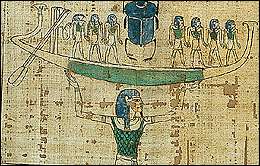








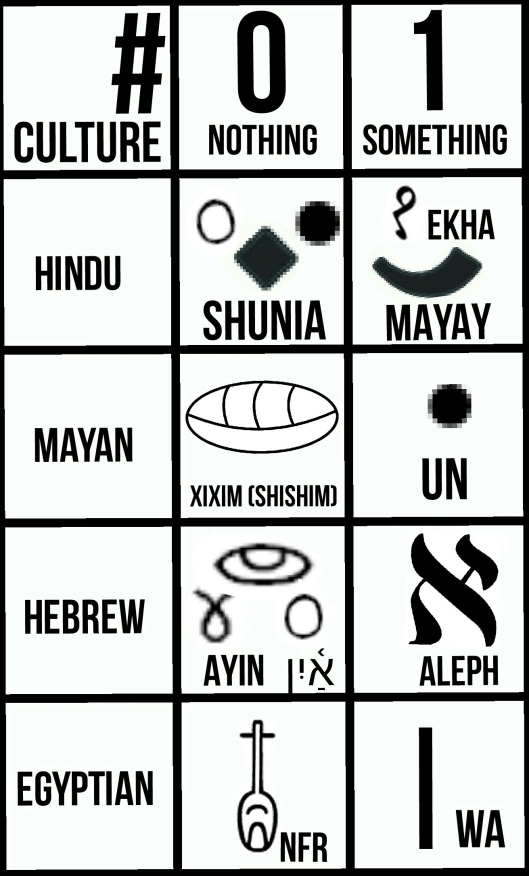





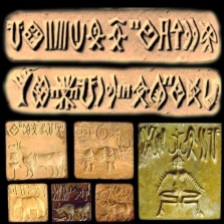






 the Mayan Fish in Hand Hieroglyph means to manifest or conjure up.
the Mayan Fish in Hand Hieroglyph means to manifest or conjure up.

